| |
| 1877 |
In the first quarter of the year Draeseke completes his Six Fugues for Keyboard (F# major, D-flat major, E-flat minor, C minor, A minor and D major), Op. 15. At the same time he works on his opera "Dietrich von Bern", which is later renamed "Herrat". "Immergrün" (Evergreen), one of the "Dämmerungsträume" (Dreams at Twilight) is composed in March. By the end of August, Draeseke finishes "Fata Morgana, Ein Ghaselenkranz" (Fata Morgana: A Wreath of Ghasels) for Piano, Op. 13. Draeseke supposedly writes a political novel, "Die Eiszeit" (The Time of Ice), a work unmentioned outside of Roeder's biography. |
| 1878 |
The year brings the premieres of the Symphony No. 2 in F major, Op. 25 (Dresden/Schuch) and "Adventlied" (Advent Song), Op. 30 (Dresden/Reichelt). Draeseke remains without steady employment, and lives on income from his private students. |
| 1879 |
In February Draeseke declares his opera "Herrat" (originally "Dietrich von Bern") to be complete and attempts unsuccessfully to get a production at the Dresden Court Opera. Already in October, Draeseke has begun work on the text of his next opera, "Gudrun". During the summer Draeseke completes a theoretical treatise "Die Beseitigung des Tritonus" (Elimination of the Tritone). |
| 1880 |
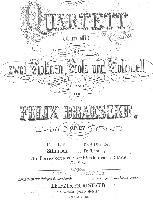 Draeseke writes his String Quartet No. 1 in C minor, Op. 27 (not to be confused with the earlier student work in the same key which the composer apparently destroyed), and completes his Requiem in B minor, Op. 22, which includes the Lacrimosa already published as Op. 10. During the summer Draeseke concentrates on song composition and produces "Weihestunden" (Hours of Dedication, six songs for middle voice and piano), Op. 16, "Buch des Frohmuts" (Book of Cheerfulness, six songs for middle voice and piano) Op. 17, "Bergidylle" (Mountain Idyll, Ballad after Heine for middle voice and piano) Op. 18, "Trauer und Trost" (Sadness and Succor, six songs for middle voice and piano) Op. 24, and "Liebeswonne und -weh" (Love's Bliss and Sorrow, six songs for middle voice and piano) Op. 29. Parts of the song collections Opp. 20, 28, 33, and 34 are also finished. Draeseke writes his String Quartet No. 1 in C minor, Op. 27 (not to be confused with the earlier student work in the same key which the composer apparently destroyed), and completes his Requiem in B minor, Op. 22, which includes the Lacrimosa already published as Op. 10. During the summer Draeseke concentrates on song composition and produces "Weihestunden" (Hours of Dedication, six songs for middle voice and piano), Op. 16, "Buch des Frohmuts" (Book of Cheerfulness, six songs for middle voice and piano) Op. 17, "Bergidylle" (Mountain Idyll, Ballad after Heine for middle voice and piano) Op. 18, "Trauer und Trost" (Sadness and Succor, six songs for middle voice and piano) Op. 24, and "Liebeswonne und -weh" (Love's Bliss and Sorrow, six songs for middle voice and piano) Op. 29. Parts of the song collections Opp. 20, 28, 33, and 34 are also finished. |
| 1881 |
Draeseke's major work of the year, the Concerto in E minor for Violin and Orchestra, WoO 15, is written in the months May to July. His Requiem in B minor, Op. 22 is premiered in October (Dresden, Blaßmann). Draeseke's Ballad "Ritter Olaf" after Heine, is published as Op. 19, as well as the completed Op. 26, "Vermischte Lieder" (Mixed Songs, six for middle voice and piano). "An den Mond" (To the Moon, for voice and piano), WoO 16 is composed but never published. Already fluent in French, Draeseke undertakes intensive study of English. |
| 1882 |
While employed at the Rollfuss Academy for Women in Dresden, Draeseke makes the acquaintance Frida Neuhaus, his future wife. In eight days in August, Draeseke completes his overture to the opera "Gudrun", finished in short score in November, but not fully orchestrated until the following spring. WoO 17, "Der Waldschatzhauser" (The Forester's Domain), based on Wilhelm Hauff's "Das kalte Herz" (The Frigid Heart) and called "Volksstück mit Gesang" (A Folk Piece with Song) is finished but neither published nor staged. |
| 1883 |
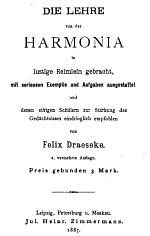 In January the "Gudrun" Overture receives its first performance (Dresden/ Wüllner) and in February Draeseke is stunned by the news of Wagner's death. Later in the year Draeseke contributes to the Luther celebrations with his essay "Kirchenmusikalischen Yeitfragen" (Contemporary Questions Regarding Church Music). Five lyrical pieces for piano, "Was die Schwalbe sang" (What the Swallow Sang), Op. 21, and the "Miniaturen" (Miniatures, six pieces for piano) Op. 23, as well as the booklet, "Die Lehre von der Harmonia in lustige Reimlein gebracht" (Treatise on Harmony Rendered in Merry Verse) all appear before Draeseke, in anticipation of a performance in Hannover, devotes his time to revising his opera "Gudrun". In January the "Gudrun" Overture receives its first performance (Dresden/ Wüllner) and in February Draeseke is stunned by the news of Wagner's death. Later in the year Draeseke contributes to the Luther celebrations with his essay "Kirchenmusikalischen Yeitfragen" (Contemporary Questions Regarding Church Music). Five lyrical pieces for piano, "Was die Schwalbe sang" (What the Swallow Sang), Op. 21, and the "Miniaturen" (Miniatures, six pieces for piano) Op. 23, as well as the booklet, "Die Lehre von der Harmonia in lustige Reimlein gebracht" (Treatise on Harmony Rendered in Merry Verse) all appear before Draeseke, in anticipation of a performance in Hannover, devotes his time to revising his opera "Gudrun". |
| 1884 |
Minor essays for music journals mirror Draeseke's hindered productivity due to preparations for the projected "Gudrun" premiere, which finally takes place in Hannover under Hans von Bronsart on 21 November  . .
At the beginning of September Draeseke finally gets an official appointment to the faculty of the Dresden Conservatory. |
| 1885 |
Despite the success of "Gudrun" Draeseke decides on a reworking of the score, as well as more revision of the still unperformed "Herrat". A text for a new opera, "Valeria, die Märtyrerin" (Valeria, The Martyr) is written, but is never used. "Drei Gesänge für Männerchor" (Three Songs for Male Chorus), Op. 28 and two pieces for horn and piano, Adagio, Op. 31 and "Romanze" (Romance), Op. 32 are published. |
| 1886 |
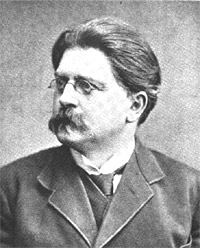 By March, Draeseke completes his Concerto in E-flat major for Piano and Orchestra, Op. 36 (premiered by its dedicatee Laura Rappoldi in June at Sondershausen where Draeseke meets Liszt for the last time, some eight week before Liszt's death) and in May, his String Quartet No. 2 in E minor, Op. 35 is finished. In November, Draeseke publishes his "Autobiographische Skizze" (Autobiographical Sketch) in Tonger's "Neue Musik-Zeitung" (New Musical Magazine). By March, Draeseke completes his Concerto in E-flat major for Piano and Orchestra, Op. 36 (premiered by its dedicatee Laura Rappoldi in June at Sondershausen where Draeseke meets Liszt for the last time, some eight week before Liszt's death) and in May, his String Quartet No. 2 in E minor, Op. 35 is finished. In November, Draeseke publishes his "Autobiographische Skizze" (Autobiographical Sketch) in Tonger's "Neue Musik-Zeitung" (New Musical Magazine).
On 7 December, after ten years of planning, Draeseke completes his Symphony No. 3 in C major, Op. 40, "Symphonia Tragica". |
| 1887 |
In February Draeseke completes his Op. 39, the "Osterscene aus Goethe's  'Faust'," (Easter Scene from Goethe's "Faust") for Baritone, Mixed Choir and Orchestra, which he had begun during his first year in Switzerland. In May Draeseke completes his Sonata for Clarinet and Piano in B-flat major (with alternate version for violin), Op. 38. A work for unaccompanied mixed chorus on a poem by August Kopisch, "Die Heinzelmännchen" (The Little People), Op. 41 is completed in August and carries the designation "Konzertstück" - Concert Piece, a term usually reserved for a short solo work with orchestra. For male chorus unaccompanied, Draeseke sets August Dahn's poem "Dem Deutschen Volk Ist Gegeben" (It is Given to the German Nation), Op. 46. 'Faust'," (Easter Scene from Goethe's "Faust") for Baritone, Mixed Choir and Orchestra, which he had begun during his first year in Switzerland. In May Draeseke completes his Sonata for Clarinet and Piano in B-flat major (with alternate version for violin), Op. 38. A work for unaccompanied mixed chorus on a poem by August Kopisch, "Die Heinzelmännchen" (The Little People), Op. 41 is completed in August and carries the designation "Konzertstück" - Concert Piece, a term usually reserved for a short solo work with orchestra. For male chorus unaccompanied, Draeseke sets August Dahn's poem "Dem Deutschen Volk Ist Gegeben" (It is Given to the German Nation), Op. 46. |
| 1888 |
In January the "Symphonia Tragica" is premiered in Dresden (Schuch) and later in the same month the Clarinet Sonata in B-flat, Op. 38 is premiered and the next evening the violin version is given. Music for piano, the "Rückblicke" (Retrospections, five lyrical pieces) Op. 43 and "Scheidende Sonne, Neun Albumblätter" (Parting Sun, Nine Entries for an Album), Op. 44 - not to be confused with the unpublished "Neun Albumblätter" (Nine Entries for the Album), WoO 19 of this same year - and piano four hands, Kanonische Rätsel (Canonic Puzzles), Op. 42 and 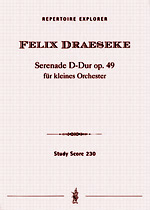 Canons for 6,7, and 8 Voices, Op. 37 begun in 1882/83, occupies Draeseke through mid-year. His single completed vocal work of the year, a setting of August von Platen's "Meleagerchor" (Chorus of the Meleager) WoO 18 for six part mixed choir Thereafter Draeseke is occupied with completing two symphonic preludes, one for Calderon's "Das Leben ein Traum" (Life Is a Dream), Op. 45 and one for Kleist's "Penthesilea", Op. 50, which are followed by the Quintet, Op. 48 for the unusual combination of Piano, Horn and String Trio. The year ends with the completion of the five movement Serenade in D major for Orchestra, Op. 49. Canons for 6,7, and 8 Voices, Op. 37 begun in 1882/83, occupies Draeseke through mid-year. His single completed vocal work of the year, a setting of August von Platen's "Meleagerchor" (Chorus of the Meleager) WoO 18 for six part mixed choir Thereafter Draeseke is occupied with completing two symphonic preludes, one for Calderon's "Das Leben ein Traum" (Life Is a Dream), Op. 45 and one for Kleist's "Penthesilea", Op. 50, which are followed by the Quintet, Op. 48 for the unusual combination of Piano, Horn and String Trio. The year ends with the completion of the five movement Serenade in D major for Orchestra, Op. 49. |
| 1889 |
By May Draeseke completes his six voice Motet, "Salvum fac regem, Domine", Op. 55 and eight voice setting of Psalm, Op. 56, as well as Four Choruses for Female Voices, Op. 47 and a setting of Psalm 23 for either three part women's chorus or boys' choir, Op. 59. In mid-December Draeseke finishes his "Columbus" Cantata for Soprano, Baritone, Male Chorus and Orchestra, Op. 52. |
| 1890 |
In the early months of the year Draeseke composes his Sonata in D major for Violoncello and Piano, Op. 51 and an a-capella setting of Adolf Stern's "Gesang zur Fahnenweihe" (Song for the Consecration of the Flag), WoO 20. In May the "Akademische Festouvertüre" (Academic Festival Overture), Op. 63 is ready. Draeseke is not present at the disastrous June premiere of the symphonic prelude "Penthesilea" at Eisenach conducted by the young Richard Strauss. In November Draeseke begins his Grand Mass in F# minor, Op. 60 by completing the Gloria and the following month, the Agnus Dei. |
| 1891 |
In April Draeseke completes his Grand Mass in F# minor for Soloists, Chorus and Orchestra, Op. 60. In November two small-scale works are composed, the "Vier geistliche Gesänge" (Four Spiritual Songs), Op. 57 and "Jubiläumsfestmarsch" (Jubilee Festival March), Op. 54. Hermann Kretzschmar conducts the premiere of the "Columbus" Cantata, Op. 52 in Leipzig in February and later in the year Felix Weingartner gives the Serenade in D major, Op. 49 in truncated form at its "premiere" in Berlin. |
| 1892 |
Draeseke's only completed new work for the year is the Sonata No. 1 in C minor for Viola alta and Piano, WoO 21. His major pre-occupation has to do with the premiere of his opera "Herrat" at the Dresden opera conducted by Schuch, which proves to be most successful. Shortly thereafter Draeseke is given the rank of full professor at the Dresden Conservatory. The cello sonata (Dresden) and Grand Mass (in Leipzig under Kretzschmar) receive their premieres. |
| 1893 |
Draeseke finishes a first version of his fourth opera, "Bertran de Born", WoO 22 and completes his "Sachsenhymne" (Saxon Hymn) for Male Chorus and Orchestra, WoO 23, both of which remain unperformed. |
| 1894 |
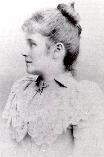 The year begins sadly for Draeseke, with the death of his friend Hans von Bülow on 12 February. In May, however, he celebrates one of the happiest events of his life, his marriage to his one time pupil Frida Neuhaus. The year begins sadly for Draeseke, with the death of his friend Hans von Bülow on 12 February. In May, however, he celebrates one of the happiest events of his life, his marriage to his one time pupil Frida Neuhaus.
Draeseke writes the text and begins the music for his fifth opera, a "comic opera with dance" from a tale of the "Thousand and One Nights", called "Fischer and Kalif" (Fisher and Caliph), WoO 24. |
| 1895 |
Draeseke finishes "Fischer und Kalif", WoO 24, though only adds an overture two years later. In September the String Quartet No. 3 in C# minor, Op. 66 is ready. Draeseke decides to make a final organizing of materials and begin his Mysterium in a Prologue and Three Oratorios, "Christus", Opp. 70, 71, 72, and 73. |
| 1896 |
Draeseke is able to publish two volumes of songs, "Fünf Gesänge" (Five Songs for Voice and Piano), Op. 61 and the "Vier Gesänge" (Four Songs for Voice and Piano), Op. 62. The year is otherwise occupied with continued work on "Christus". |
| 1897 |
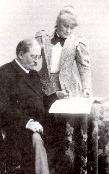 In less than three weeks (January-February) Draeseke writes his Quintet in A major for Two Violins, Viola, Violotta and Cello, WoO 25. It is named the "Stelzner" Quintet after Alfred Stelzner, the developer of the unsuccessful violotta, described as a type of "tenor viola", but often replaced today by cello. "Der deutsche Sang" (The German Song for male chorus and orchestra), Op. 64 is written and Draeseke completes the second oratorio of " Christus", "Christus der Prophet", (Christus the Prophet), Op. 72. Draeseke composes and publishes his Ballad for low voice and piano, "Der Tod kennt den Weg" (Death Knows the Path), Op. 58. In December the "Stelzner" Quintet is premiered in Dresden. Brahms has died earlier in the year. In less than three weeks (January-February) Draeseke writes his Quintet in A major for Two Violins, Viola, Violotta and Cello, WoO 25. It is named the "Stelzner" Quintet after Alfred Stelzner, the developer of the unsuccessful violotta, described as a type of "tenor viola", but often replaced today by cello. "Der deutsche Sang" (The German Song for male chorus and orchestra), Op. 64 is written and Draeseke completes the second oratorio of " Christus", "Christus der Prophet", (Christus the Prophet), Op. 72. Draeseke composes and publishes his Ballad for low voice and piano, "Der Tod kennt den Weg" (Death Knows the Path), Op. 58. In December the "Stelzner" Quintet is premiered in Dresden. Brahms has died earlier in the year. |
| 1898 |
For the seventieth birthday celebrations for King Albert of Saxony Draeseke fashions his "Jubel Ouvertüre" (Jubilee Overture), Op. 65 and is elevated by the king to "Hofrat" (Court Councillor). The prelude to "Christus", "Geburt des Herrn" (Birth of the Lord), Op. 70 is finished in mid-May and Draeseke loses his brother Hilmar the following week The remainder of the year is dedicated to further work on "Christus". |
| 1899 |
"Fünf Gesänge nach Nordryck" (Five Songs for middle voice and piano after Nordryck), Op. 67 and "Drei Gesänge nach C.F. Meyer" (Three Songs after C.F. Meyer for middle voice and piano), Op. 68 are composed and published. The "Scene" (German original) for Violin and Piano, Op. 69, containing some material from "Bertran de Born" is composed in leisure time during the summer, but it is the completion of the "Christus" Mysterium which is Draeseke's major achievement as the century comes to its end. In January Draeseke finishes the third oratorio "Tod und Sieg des Herrn" (Death and Triumph of the Lord), Op. 73 and in September the final touches are put to the first oratorio, "Christi Weihe" (Christ's Consecration), Op. 71. |
| Note: |
 : This icon indicates that there is original material regarding this event in the Ebert collection. Click the icon to view those pages. : This icon indicates that there is original material regarding this event in the Ebert collection. Click the icon to view those pages. |
|
|
 Draeseke writes his String Quartet No. 1 in C minor, Op. 27 (not to be confused with the earlier student work in the same key which the composer apparently destroyed), and completes his Requiem in B minor, Op. 22, which includes the Lacrimosa already published as Op. 10. During the summer Draeseke concentrates on song composition and produces "Weihestunden" (Hours of Dedication, six songs for middle voice and piano), Op. 16, "Buch des Frohmuts" (Book of Cheerfulness, six songs for middle voice and piano) Op. 17, "Bergidylle" (Mountain Idyll, Ballad after Heine for middle voice and piano) Op. 18, "Trauer und Trost" (Sadness and Succor, six songs for middle voice and piano) Op. 24, and "Liebeswonne und -weh" (Love's Bliss and Sorrow, six songs for middle voice and piano) Op. 29. Parts of the song collections Opp. 20, 28, 33, and 34 are also finished.
Draeseke writes his String Quartet No. 1 in C minor, Op. 27 (not to be confused with the earlier student work in the same key which the composer apparently destroyed), and completes his Requiem in B minor, Op. 22, which includes the Lacrimosa already published as Op. 10. During the summer Draeseke concentrates on song composition and produces "Weihestunden" (Hours of Dedication, six songs for middle voice and piano), Op. 16, "Buch des Frohmuts" (Book of Cheerfulness, six songs for middle voice and piano) Op. 17, "Bergidylle" (Mountain Idyll, Ballad after Heine for middle voice and piano) Op. 18, "Trauer und Trost" (Sadness and Succor, six songs for middle voice and piano) Op. 24, and "Liebeswonne und -weh" (Love's Bliss and Sorrow, six songs for middle voice and piano) Op. 29. Parts of the song collections Opp. 20, 28, 33, and 34 are also finished. 


 Canons for 6,7, and 8 Voices, Op. 37 begun in 1882/83, occupies Draeseke through mid-year. His single completed vocal work of the year, a setting of August von Platen's "Meleagerchor" (Chorus of the Meleager) WoO 18 for six part mixed choir Thereafter Draeseke is occupied with completing two symphonic preludes, one for Calderon's "Das Leben ein Traum" (Life Is a Dream), Op. 45 and one for Kleist's "Penthesilea", Op. 50, which are followed by the Quintet, Op. 48 for the unusual combination of Piano, Horn and String Trio. The year ends with the completion of the five movement
Canons for 6,7, and 8 Voices, Op. 37 begun in 1882/83, occupies Draeseke through mid-year. His single completed vocal work of the year, a setting of August von Platen's "Meleagerchor" (Chorus of the Meleager) WoO 18 for six part mixed choir Thereafter Draeseke is occupied with completing two symphonic preludes, one for Calderon's "Das Leben ein Traum" (Life Is a Dream), Op. 45 and one for Kleist's "Penthesilea", Op. 50, which are followed by the Quintet, Op. 48 for the unusual combination of Piano, Horn and String Trio. The year ends with the completion of the five movement  The year begins sadly for Draeseke, with the death of his friend Hans von Bülow on 12 February. In May, however, he celebrates one of the happiest events of his life, his marriage to his one time pupil Frida Neuhaus.
The year begins sadly for Draeseke, with the death of his friend Hans von Bülow on 12 February. In May, however, he celebrates one of the happiest events of his life, his marriage to his one time pupil Frida Neuhaus. In less than three weeks (January-February) Draeseke writes his Quintet in A major for Two Violins, Viola, Violotta and Cello, WoO 25. It is named the "Stelzner" Quintet after
In less than three weeks (January-February) Draeseke writes his Quintet in A major for Two Violins, Viola, Violotta and Cello, WoO 25. It is named the "Stelzner" Quintet after